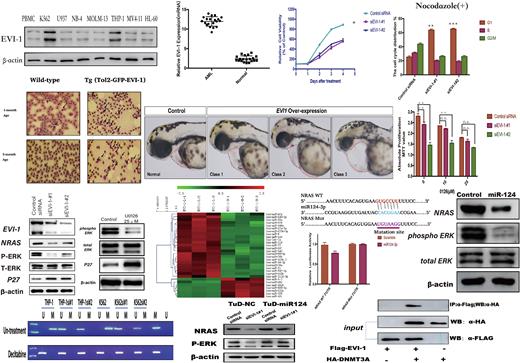Abstract
BACKGROUNDː Acute myeloid leukemia (AML) is an aggressive hematological malignancy characterized by genetic mutations that promote proliferation of myeloid progenitors and prevent their differentiation. Over-expression of Ectopic Viral Integration site-1(EVI-1) is related to the poor prognosis in myeloid leukemia, but the underlying mechanism remains unclear.
METHODSː Using qRT-PCR and western blotting, we quantified expressions of EVI-1, NRAS and ERK/p-ERK in leukemia cell lines and PBMCs. Using WTS-8 and cell cycle analysis, we further investigated whether downregulation of EVI-1 by siRNA can inhibit cell proliferation. Microscopic observation of peripheral blood cells from EVI-1 transgenic zebrafish and WT control were analyzed by Wright Giemsa staining. Using miR-seq, qPCR, dual-luciferase reporter and coimmunoprecipitation assays, we revealed the relationship between EVI-1, miR-124 and NRAS.
RESULTSː EVI-1 was highly expressed in both primary AML and leukemia cell lines (THP-1 and K562). In a transgenic zebrafish model, EVI-1 mediated higher mortality and induced immature hematopoietic cells in the blood circulation, suggesting its oncogenic role. Furthermore, our results suggested that EVI-1 upregulated NRAS expression, thereby activating the RAS/ERK pathway through epigenetic silencing of a potent NRAS suppressor, miR-124. In this study, we found that EVI1 physically interacts with Dnmt3a to form a protein complex that targets and binds to regulatory elements of miR-124.
CONCLUSIONSː Overall, the current findings demonstrate that EVI-1 overexpression converges on the regulation of miR-124 promoter methylation and activation of the RAS/ERK pathway in AML carcinogenesis, and suggest EVI-1 and/or miR-124 as therapeutic targets for this dismal disease.
Disclosures
No relevant conflicts of interest to declare.
Author notes
Asterisk with author names denotes non-ASH members.


This feature is available to Subscribers Only
Sign In or Create an Account Close Modal